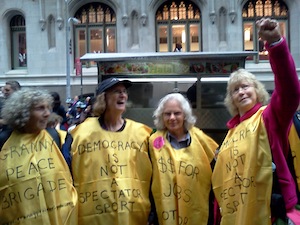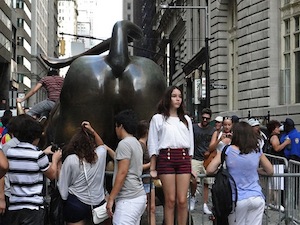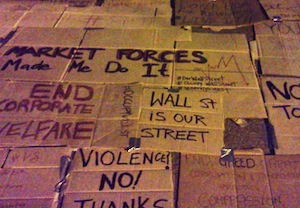 Sure, Occupy Wall Street has students with cardboard signs and a couple of socialists. But the tenacious band of occupiers doesn’t have the tactics, demands or personalities of stereotype.
Sure, Occupy Wall Street has students with cardboard signs and a couple of socialists. But the tenacious band of occupiers doesn’t have the tactics, demands or personalities of stereotype.
[I’ve followed Occupy Wall Street from the start and had a hard time getting publications to understand it – hats off to Fast Company, which did. I wasted time with others. One would have offered a very visible, um, slate. And the other is a new york magazine. In my last (and requested) proposal to the latter, I showed what the first paragraphs might look like.]

It began looking painfully familiar. An unimpressive handful of activists with a bullhorn scarcely filled the smidgen of pavement facing the butt of the Wall Street bronze bull. And the rhetoric was well worn. “We must fight back by all means necessary,” said Larry Hales, a dreadlocked organizer of the group New Yorkers Against Budget cuts. “Abolish capitalism!” yelled Caleb, a long-haired student clutching a stack of Communist party “Workers World” newspapers. At one point, someone made the inevitable Hitler comparison.
Then a woman named Georgia, a Greek student spoke up – loudly. “This is not the way that a general assembly is happening! This is a rally!” After a shouting match with one of the bullhorn bearers, she pulled away from the rally and invited others to follow her. Slowly they did, at least, all the students and a handful of older folks who didn’t look like standard lifetime activists.
The rally grew smaller and the old-timers drifted away while the “general assembly” discussion got down to business. With the cool focus and tech savvy of Millennials, the group went into detailed planning for their impossible goal – getting 20,000 people to Wall Street in 6 weeks for a multi-month, Cairo-style occupation.

That didn’t happen. Not on the ground, at least.
But a few hundred tenacious kids have held Zuccotti Park, a short dash from Wall Street and with a view of Ground Zero, and pulled in support of everyone from Salman Rushdie and Keith Olbermann to Roseanne Barr and The-Rent-Is-Too-Damn-High guy. In a way, the demonstration has gathered tens of thousands of members, if you count online sympathizers. So much so that the protest is best known by its Twitter hashtag #occupywallstreet.
 It is not a model of organization and clarity. A hodgepodge of groups is shakily holding together and struggling to even come up with a demand of the U.S. power elite. But it’s a fascinating preview of how U.S. activism – at least left-wing activism – has changed and where it may be headed. The 60’s and 70’s types are insignificant. But supporters of TEA Party darling Ron Paul are plentiful. A few anarchists mill around, but they aren’t smashing windows like in Seattle in 1999. In fact, instead of denouncing the NYPD, even after a crackdown in which some of them were pepper-sprayed, the occupiers continue to promote nonviolence towards the cops, and among some, a measure of respect for the dilemma of the rank-and-file – a less-dangerous version of slipping flowers into gun barrels.
It is not a model of organization and clarity. A hodgepodge of groups is shakily holding together and struggling to even come up with a demand of the U.S. power elite. But it’s a fascinating preview of how U.S. activism – at least left-wing activism – has changed and where it may be headed. The 60’s and 70’s types are insignificant. But supporters of TEA Party darling Ron Paul are plentiful. A few anarchists mill around, but they aren’t smashing windows like in Seattle in 1999. In fact, instead of denouncing the NYPD, even after a crackdown in which some of them were pepper-sprayed, the occupiers continue to promote nonviolence towards the cops, and among some, a measure of respect for the dilemma of the rank-and-file – a less-dangerous version of slipping flowers into gun barrels.
And despite the talk of Twitter and Facebook revolutions from Tehran to Cairo, #occupywallstreet may be the first genuine social-media rebellion. While only a few hundred people camp out and go on daily marches to Wall Street, the movement persists as one of the top Twitter trends – pulling in celebrity endorsements and drawing way out-of-proportion news coverage around the world.
[If paid to do an article, I would have written more…]

Pingback: Occupy Wall Street: Not the Same Old Hey-Hey-Ho-Ho | Aimee Baldridge